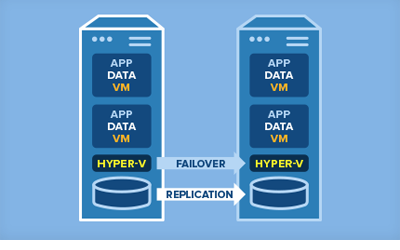HA for Virtual Server Environments
Availability clustering is a common feature of hypervisors such as VMware, Hyper-V, KVM, and XenServer. It provides a simple virtual machine restart. Simple restart techniques have no visibility into application issues causing outages or storage problems that require action. Hypervisor-based restart requires application downtime for maintenance/upgrades and you can’t easily roll back from upgrade failures or viruses. Most importantly, hypervisor-based availability can’t make guarantees a restart will even succeed in the event of a failure. This falls far short of providing the kind of comprehensive availability provided by high availability clustering that enterprises depend on.
SIOS SANless cluster software provides the enterprise-grade high availability, reliability, and flexibility needed for your most important applications when operating in virtualized environments. Use SIOS LifeKeeper for Linux to protect critical Linux applications like SAP and databases such as Oracle, MySQL, or Postgres in virtualized environments. SIOS DataKeeper provides a unique software add-on to Microsoft Windows Server Failover Clusters (WSFC) to allow Microsoft Clusters and SQL Server workloads to run in VMware, Hyper-V, KVM, and XenServer environments.
Protecting VMware Environments
VMware HA is a well-established and broadly used feature. It provides simple virtual machine restart on a second host should the primary host fail. However, simple restart techniques have no visibility into application issues or storage problems causing outages. VMware HA requires application downtime for maintenance/upgrades and you can’t easily roll back from upgrade failures or viruses. Most importantly, hypervisor-based availability can’t make guarantees that a restart will even succeed in the event of a failure. This falls far short of providing the kind of comprehensive availability that enterprises depend on.
SIOS SANless cluster software provides the enterprise-grade high availability, reliability, and flexibility needed for your most important applications when operating in VMware environments. Use SIOS Protection Suite for Linux to protect critical Linux applications like SAP and databases such as Oracle, MySQL, or Postgres in VMware environments. SIOS DataKeeper provides a unique software add-on to Microsoft Windows Server Failover Clusters (WSFC) to allow Microsoft Clusters and SQL Server workloads to run in VMware.
Real-Time Replication in VMware
SIOS software uses real-time replication to synchronize storage on the primary VM with storage on a standby VM located in the same data center, in your disaster recovery site, or both. This allows you to build VM high availability and disaster recovery configurations flexibly. Two, three or four node clusters allow high availability configurations using local LAN and multiple hosts to be coupled with disaster recovery configurations across a WAN to a remote data center. In the event of a disaster, the standby VM is brought into service automatically with no data loss, eliminating the hours needed for restoration from backup media. You simply access the replicated VMs in the DR site directly.
Key Benefits of SIOS High Availability Clustering in VMware
If you’re using standard high availability clustering software like Windows Server Failover Clusters (WSFC), RDM is required in a VMware environment. RDM ties the virtual machines in the cluster to specific physical storage devices. This eliminates one of the great benefits of VMware – flexibility and mobility of clustered virtual machines is not possible.
SIOS SANless clusters eliminate the need to use RDM, giving you complete configuration flexibility and protecting the value VMware operations provides even when clustering virtual machines. You simply allocate separate VMDK’s for SIOS clustered virtual machines, just as you would any other virtual machines, and use SIOS data replication to achieve complete data redundancy and protection between the clustered virtual machines.
Virtual Server Protection via Real-Time Replication in Hyper-V, KVM, and XenServer
SIOS software uses real-time replication to synchronize storage on the primary VM with storage on a standby VM located in the same data center, in your disaster recovery site, or both. This allows you to build high availability and disaster recovery configurations flexibly. Two, three or four VM (node) clusters allow high availability configurations using local LAN and multiple hosts to be coupled with disaster recovery configurations across a WAN to a remote data center. In the event of a disaster, the standby VM is brought into service automatically with no data loss, eliminating the hours needed for restoration from backup media. You simply access the replicated VMs in the DR site directly.
Hyper-V Host Clusters

SIOS SANless software allows you to cluster entire Microsoft Hyper-V host machines at the hypervisor level for complete VM portability and failover protection. By keeping a real-time copy of the running VM synchronized on an alternate Hyper-V host, SIOS allows you to easily failover or Live Migrate a VM from one Hyper-V host to another. You can move individual VMs or all of the VMs on a host to another Hyper-V host in the cluster to eliminate downtime.
